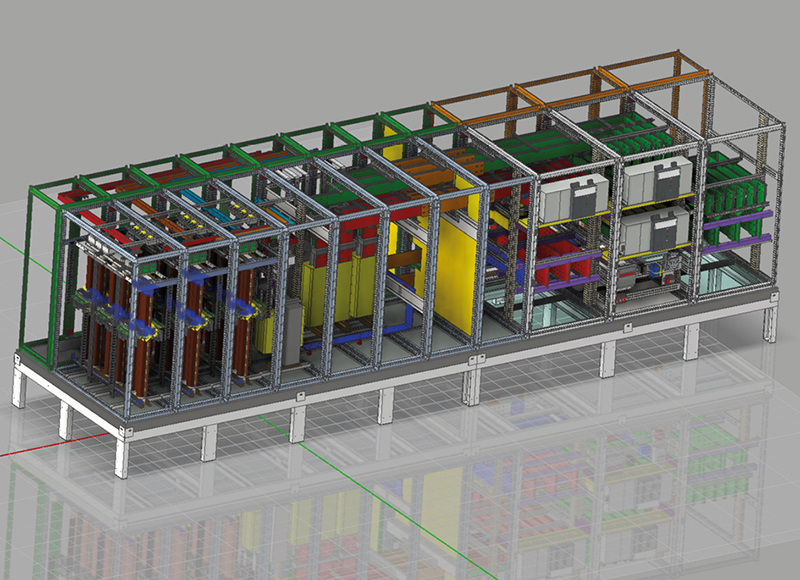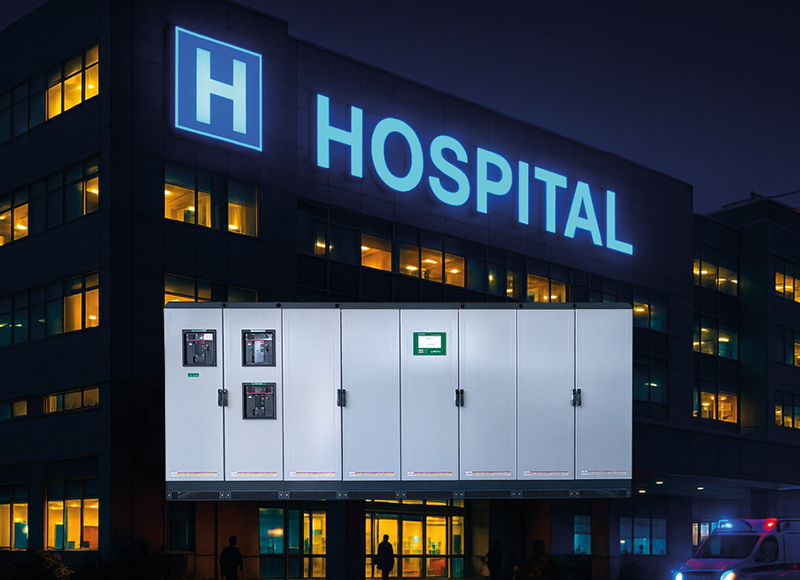In India, two Odyssey 500-30 electronic stabilisers were installed in a new HV→MV substation to protect auxiliary services. The solution ensures stable LV voltage by mitigating fast disturbances not handled by the OLTC.
POWER QUALITY IN SUBSTATIONS: VOLTAGE VARIATIONS AND MITIGATION
Substations are critical nodes where power and data are transformed and distributed. Here, voltage quality is put to the test by:
- Rapid load variations (motor starts, switching of capacitor/reactor banks, network reconfigurations).
- Transients and sags/swells induced by upstream manoeuvres or faults.
- Long/weak feeders that amplify voltage drops and rebounds.
- Interactions with distributed generation (PV/wind) that introduce rapid fluctuations.
Substation auxiliaries (relays, IEDs, SCADA, PLCs, battery chargers, UPSs, measurements) are sensitive: even short-lived variations can generate false trips or malfunctions. The transformer’s OLTC is excellent in the medium term, but its dynamics are slow; therefore, a fast “downstream” loop is needed.
WHY VOLTAGE FLUCTUATIONS ARE FREQUENT IN COUNTRIES SUCH AS INDIA
Without generalising, in contexts characterised by:
- High load variability (industrial/civil mix, pumps, traction, HVAC) and growth in demand.
- High penetration of renewables with rapid ramp rates (cloud cover over large PV fields, wind gusts).
- Extensive lines and mixed urban-rural networks (higher impedance, more pronounced drops).
- Frequent maneuvers for congestion management.
Voltage fluctuations and surges are more likely. In these cases, an electronic stabiliser with a millisecond response reduces the exposure of auxiliaries to disturbances between OLTC taps.
THE SOLUTION: ELECTRONIC VOLTAGE STABILISER
For the new HV→MV substation under construction in India, we supplied two Odyssey 500-30 units with the aim of stabilising the LV of the auxiliary services and ensuring the continuity and reliability of the protection and control systems.
APPLICATION OBJECTIVE
- To stabilise the 415/230 V voltage of the auxiliary services (protections, IED/SCADA, PLC, UPS, battery chargers) by filtering short-term sags/swells and rapid variations that the OLTC does not intercept in time.
SUPPLY DATA (FOR EACH UNIT)
- Model: Odyssey 500-30.
- Power: 500 kVA.
- Input adjustment range: ±30%.
- Output stability: ±0.5% (rapid electronic adjustment).
- Installed option: 800 A output circuit breaker (protection and isolation).
BENEFITS FOR THE SUBSTATION
- Continuity of auxiliary services: fewer false trips, greater availability.
- Clean and constant voltage: improved reliability of relays/IEDs and measurements.
- Coordination with OLTC: OLTC manages the long term, Odyssey manages the dynamic.
- Reduction of perceived flicker: on sensitive loads.
- Integrated protection: (with 800 A circuit breaker) for maintainability and safety.
ORTEA’S EXPERTISE IN VOLTAGE STABILISERS
Ortea has been designing and manufacturing voltage stabilisers for decades, with:
- Fast-response electronic architectures (semiconductor switching) designed for critical environments.
- Extended range and ±0.5% output tolerance.
- An application-based engineering approach: sizing based on actual disturbance profiles, coordination with OLTC/power factor correction/STATCOM, bypass and protection strategies.
- Functional tests and inspections in accordance with applicable standards, with clear and traceable reports.
Discover Ortea’s range of stabilisers
ORTEA AS A GLOBAL PARTNER
With an international presence and a technical team accustomed to working with utilities, EPCs and OEMs, Ortea supports projects around the world, from requirements definition to commissioning.
The consolidated supply chain and after-sales service guarantee reliable delivery times and local support, even in complex infrastructure contexts.
FAQ
- What is the role of an electronic voltage stabiliser in a substation?
It compensates for rapid fluctuations within milliseconds that the OLTC cannot handle in time, keeping LV supply stable for auxiliary systems. - When is a ±30% input regulation range needed?
It is essential in networks with high variability due to renewables, weak lines or intermittent loads, ensuring stable voltage in extreme conditions. - Do Ortea stabilisers generate harmonics?
No. Odyssey models are engineered to minimise distortion and comply with EMC standards and power factor correction systems. - Can they be used with UPS and battery chargers?
Yes. A stable input voltage improves UPS efficiency and lifespan, reducing battery transfer events.







